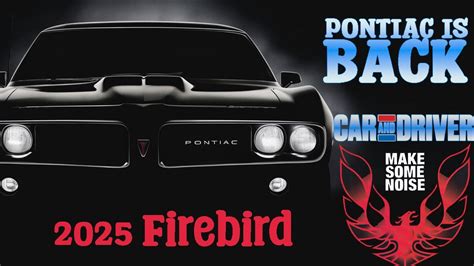
Pontiac, the defunct General Motors brand, may be poised for an unexpected resurgence, according to recent reports suggesting GM is considering reviving the iconic nameplate to compete with Ford’s Mustang and other performance vehicles. The move, if realized, would mark a significant shift in GM’s strategy and a potential boon for automotive enthusiasts nostalgic for the brand’s classic models.
General Motors is reportedly exploring the possibility of resurrecting the Pontiac brand, fueling speculation about a renewed focus on performance vehicles. The potential revival aims to capture a segment of the market currently dominated by Ford’s Mustang and Dodge’s Challenger, leveraging Pontiac’s historical association with sporty and affordable cars. The decision hinges on internal discussions and market analyses, with GM evaluating the feasibility and potential return on investment.
“The tantalizing prospect of a reborn Pontiac has auto enthusiasts buzzing,” noted the original Yahoo! Autos report. The brand, shuttered in 2010 amidst GM’s bankruptcy restructuring, remains a potent symbol of American automotive history, particularly for its muscle cars and performance-oriented vehicles.
The move to potentially revive Pontiac isn’t solely based on nostalgia. GM recognizes a gap in their portfolio for a dedicated performance brand that can rival Ford and Stellantis (Dodge). Currently, GM’s performance offerings are spread across Chevrolet (Corvette, Camaro), Cadillac (V-Series), and Buick (GS models in the past). A revived Pontiac could consolidate these efforts and provide a distinct identity for performance-focused vehicles.
One scenario being considered involves positioning Pontiac as an electric performance brand. This aligns with GM’s broader commitment to electrification and allows Pontiac to enter the market with a modern, environmentally conscious image, distinct from its gas-guzzling past. Electric vehicles are increasingly becoming synonymous with performance, as demonstrated by Tesla and other EV manufacturers. An all-electric Pontiac could offer impressive acceleration and handling, appealing to a new generation of car enthusiasts.
However, the decision to resurrect Pontiac is fraught with challenges. GM must carefully consider the brand’s identity, target market, and product lineup to ensure a successful relaunch. Avoiding past mistakes, such as badge engineering (simply rebadging existing GM models as Pontiacs), is crucial. The brand needs a clear and compelling value proposition that differentiates it from other GM offerings and competitors.
The choice of vehicle platforms and powertrains will also be critical. If GM opts for an electric Pontiac, it can leverage its Ultium battery platform and electric motors, which are already being used in vehicles like the Cadillac Lyriq and GMC Hummer EV. However, an electric-only strategy might alienate traditional Pontiac enthusiasts who prefer internal combustion engines.
Another challenge is brand perception. Pontiac, in its final years, suffered from declining sales and a diluted brand image. Rebuilding consumer trust and excitement will require significant marketing efforts and a commitment to delivering high-quality, desirable vehicles.
The revival of Pontiac could also impact other GM brands. Chevrolet, in particular, might see some overlap in its target market. Careful product planning and brand positioning will be essential to avoid cannibalizing sales and maintaining distinct brand identities.
Industry analysts suggest that GM is likely exploring various scenarios and conducting market research to assess the potential success of a Pontiac revival. The decision will ultimately depend on a complex interplay of factors, including market trends, competitive pressures, and internal priorities.
The potential return of Pontiac is not just about reviving a defunct brand; it’s about GM’s strategic response to the evolving automotive landscape. As the industry shifts towards electrification and performance remains a key selling point, Pontiac could be GM’s answer to competitors like Ford and Dodge.
Detailed Analysis and Background
The Pontiac Motor Division, a stalwart of American automotive manufacturing, ceased operations in 2010 following General Motors’ bankruptcy and subsequent restructuring. Founded as the Oakland Motor Car Company in 1907, it was acquired by GM in 1909 and renamed Pontiac in 1926, after a city in Michigan and a famous Native American chief. Pontiac quickly gained a reputation for building affordable and sporty cars, distinguishing itself from Chevrolet with more performance-oriented models.
Throughout its history, Pontiac produced a series of iconic vehicles that have become enshrined in automotive lore. The Pontiac GTO, introduced in 1964, is widely considered the first muscle car, setting the stage for a decade of high-performance vehicles. The Firebird, particularly the Trans Am variant, achieved legendary status thanks to its distinctive styling and appearances in popular culture, such as the “Smokey and the Bandit” film franchise. Other notable models include the Grand Prix, Bonneville, and Fiero.
However, Pontiac’s fortunes began to decline in the late 20th century. Shifting consumer preferences, increased competition from foreign automakers, and a lack of investment in new models contributed to the brand’s struggles. In its final years, Pontiac suffered from badge engineering, where existing GM models were simply rebadged and sold as Pontiacs, diluting the brand’s identity and alienating loyal customers. The economic crisis of 2008-2009 proved to be the final nail in the coffin, leading to GM’s decision to discontinue the Pontiac brand as part of its bankruptcy restructuring.
The potential revival of Pontiac raises several questions about GM’s long-term strategy and its approach to the performance vehicle market. GM has been investing heavily in electric vehicle technology, and the potential positioning of Pontiac as an electric performance brand could be a strategic move to capture a growing segment of the market.
The Ultium battery platform, developed by GM, is a key enabler of its electrification strategy. The platform is designed to be flexible and scalable, allowing GM to produce a wide range of electric vehicles, from compact cars to trucks and SUVs. The Ultium platform could provide the foundation for an electric Pontiac, offering competitive range, performance, and charging capabilities.
However, GM also faces the challenge of maintaining its existing performance offerings under the Chevrolet and Cadillac brands. The Chevrolet Corvette and Camaro have long been iconic performance vehicles, and Cadillac’s V-Series models offer a higher level of luxury and performance. A revived Pontiac could potentially compete with these vehicles, requiring careful product planning and brand positioning to avoid cannibalization.
The success of a Pontiac revival will depend on several factors, including the brand’s identity, product lineup, and marketing strategy. GM needs to clearly define what Pontiac stands for and how it differs from other GM brands. The product lineup needs to be compelling and desirable, offering a combination of performance, styling, and technology that appeals to a target market. The marketing strategy needs to be effective in building awareness and generating excitement for the brand.
The potential return of Pontiac also raises questions about the future of internal combustion engines. While GM is committed to electrification, it also recognizes that there is still a strong demand for gasoline-powered performance vehicles. The company may choose to offer a combination of electric and gasoline-powered models under the Pontiac brand, catering to different customer preferences.
Ultimately, the decision to revive Pontiac will depend on a careful analysis of the market, the competitive landscape, and GM’s internal priorities. The company needs to weigh the potential benefits of reviving the brand against the risks and challenges involved. If GM decides to move forward, it will need to develop a comprehensive plan that addresses the key issues and ensures the success of the Pontiac revival.
The automotive industry is cyclical, with brands rising and falling in popularity over time. The potential revival of Pontiac could be a sign that the brand is ready for a comeback, fueled by nostalgia, a renewed focus on performance, and the opportunities presented by electrification. However, GM needs to be careful not to repeat the mistakes of the past and to ensure that a revived Pontiac has a clear and compelling value proposition.
The coming months and years will be crucial in determining whether Pontiac will indeed rise from the ashes and once again become a force in the automotive market. The automotive world is watching with great interest.
Strategic Implications for General Motors
The resuscitation of Pontiac presents a multi-faceted strategic opportunity for General Motors, touching upon brand portfolio management, market segmentation, technology leadership, and competitive positioning. GM’s decision to shutter Pontiac in 2010 was a painful but necessary step during its bankruptcy restructuring. However, the automotive landscape has changed dramatically since then, and a refreshed Pontiac could potentially address unmet needs and capture new growth opportunities.
Brand Portfolio Optimization: GM currently operates a brand portfolio that includes Chevrolet, Buick, GMC, and Cadillac in North America. Each brand is positioned to appeal to a specific target market, with Chevrolet focusing on value and mainstream appeal, Buick targeting premium comfort, GMC catering to professional-grade utility, and Cadillac representing luxury and performance. However, some argue that there is a gap in the portfolio for a dedicated performance brand that sits between Chevrolet and Cadillac. A revived Pontiac could fill this gap, providing a distinct identity for performance-focused vehicles and allowing GM to better compete with brands like Ford and Dodge.
Market Segmentation and Targeting: Pontiac has a rich history of building sporty and affordable cars that appeal to a younger demographic. By reviving the brand, GM could potentially attract a new generation of customers who are not currently considering its other brands. Furthermore, Pontiac’s association with muscle cars and performance vehicles could resonate with enthusiasts who are looking for a more visceral driving experience. A well-defined target market and a compelling product lineup are essential for the success of a Pontiac revival.
Technological Leadership and Electrification: The automotive industry is undergoing a massive shift towards electrification, and GM is investing heavily in electric vehicle technology. Positioning Pontiac as an electric performance brand would allow GM to showcase its technological capabilities and capture a growing segment of the market. The Ultium battery platform provides a foundation for building a range of electric Pontiac models, from sporty coupes to high-performance SUVs. An electric Pontiac could offer impressive acceleration, handling, and range, appealing to environmentally conscious consumers who are also looking for a thrilling driving experience.
Competitive Positioning: The performance vehicle market is highly competitive, with brands like Ford, Dodge, BMW, and Mercedes-Benz vying for market share. A revived Pontiac would need to differentiate itself from these competitors by offering a unique combination of performance, styling, and technology. GM could leverage Pontiac’s heritage and brand equity to create a distinct identity that resonates with consumers. Furthermore, a focus on affordability could give Pontiac a competitive advantage, particularly in the entry-level performance segment.
Challenges and Risks
Despite the potential benefits, the revival of Pontiac also presents several challenges and risks for General Motors.
Brand Dilution: One of the biggest challenges is avoiding brand dilution. GM needs to ensure that a revived Pontiac has a clear and distinct identity that does not cannibalize sales from its other brands. Careful product planning and brand positioning are essential for avoiding overlap and maintaining distinct brand identities.
Market Acceptance: There is no guarantee that consumers will embrace a revived Pontiac. The brand suffered from declining sales and a diluted image in its final years, and GM needs to rebuild consumer trust and excitement. Significant marketing efforts and a commitment to delivering high-quality, desirable vehicles are crucial for success.
Financial Investment: Reviving a brand requires a significant financial investment. GM needs to invest in product development, manufacturing, marketing, and sales. The company needs to carefully weigh the potential benefits of a Pontiac revival against the costs and risks involved.
Execution Risks: Even with a well-defined strategy and sufficient financial investment, there are execution risks. GM needs to execute its plan effectively and efficiently to ensure the success of a Pontiac revival. This requires strong leadership, a skilled workforce, and a commitment to quality and innovation.
Impact on GM’s Existing Brands:
The resurgence of Pontiac could have significant impacts on General Motors’ existing brands, particularly Chevrolet and Cadillac.
-
Chevrolet: There might be direct competition, especially with models like the Camaro. GM would need to differentiate Pontiac to avoid cannibalizing Chevrolet’s sales. This could involve focusing Pontiac on a specific niche within the performance market, such as electric vehicles or a particular style of performance car.
-
Cadillac: Pontiac’s revival as a performance-oriented brand could potentially encroach on Cadillac’s territory, particularly with the V-Series models known for high performance and luxury. To mitigate this, Cadillac might further emphasize luxury and advanced technology, while Pontiac could concentrate on more raw, accessible performance.
-
GMC & Buick: The revival is expected to have minimal direct impact on GMC and Buick, as their target demographics and vehicle types are quite distinct. GMC focuses on trucks and SUVs, while Buick targets premium comfort.
Expert Opinions and Market Projections
Industry experts are divided on the potential success of a Pontiac revival. Some believe that the brand has the potential to resonate with consumers who are nostalgic for the brand’s classic models, while others are skeptical about GM’s ability to successfully execute a revival.
“The Pontiac brand has a lot of equity, and there’s definitely a market for affordable performance vehicles,” said one automotive analyst. “However, GM needs to be careful not to repeat the mistakes of the past. They need to clearly define what Pontiac stands for and how it differs from other GM brands.”
“I’m not convinced that there’s enough demand for another performance brand in GM’s portfolio,” said another analyst. “They already have Chevrolet and Cadillac, and I’m not sure that Pontiac can offer anything that those brands don’t already provide.”
Market projections for the performance vehicle segment are generally positive, with demand expected to remain strong in the coming years. However, the segment is also becoming increasingly competitive, with new entrants and established players vying for market share.
FAQ Section
1. Why did Pontiac shut down in the first place?
Pontiac was discontinued in 2010 as part of General Motors’ restructuring following its bankruptcy. The brand had been struggling for years with declining sales, a lack of investment, and a diluted brand identity. GM decided to eliminate Pontiac to streamline its operations and focus on its core brands.
2. What is the biggest challenge to reviving Pontiac?
One of the biggest challenges is re-establishing a clear brand identity. In its later years, Pontiac suffered from badge engineering, where existing GM models were simply rebadged as Pontiacs. The revival needs to clearly define what Pontiac stands for and how it differs from other GM brands to avoid cannibalizing sales.
3. If Pontiac returns, will it be an electric brand?
While not definitively confirmed, there is speculation that Pontiac could be positioned as an electric performance brand. This would align with GM’s broader commitment to electrification and allow Pontiac to enter the market with a modern, environmentally conscious image.
4. What Pontiac models could we see revived?
It’s too early to say definitively, but if Pontiac were to return, iconic models like the GTO, Firebird (Trans Am), and Grand Prix could be revived, potentially with modern styling and electric powertrains.
5. How soon could we see a new Pontiac vehicle?
Given the early stages of these reports, it would likely take several years for a revived Pontiac to materialize. The process involves extensive planning, design, engineering, and testing. Realistically, a new Pontiac vehicle might not appear until the mid-2020s at the earliest.







